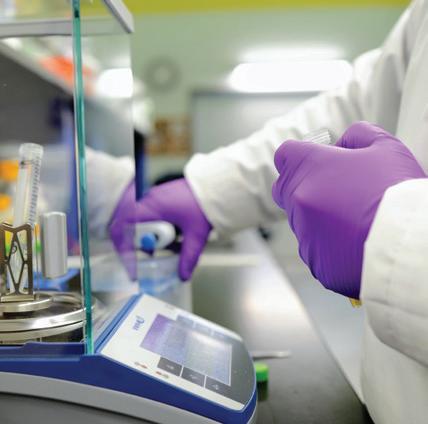
JULY 2023 www.ethanolproducer.com PLUS Making DCO RD/SAF ready PAGE 16 Turning Ethanol Into Hydrogen PAGE 30 PAGE 38 Summit Launches U.S. Wheat Biorefinery AMBER WAVE’S PATH TO PROTEIN
cte-global.com










Combining the strength of our Technology Center, Operations Services & Support, and Technical Services teams, CTE Complete creates optimized solutions for your plant’s specific needs, ensuring your success.







#FEW24 @ethanolmagazine Produced By June 10-12, 2024 MINNEAPOLIS World ’s Lar gest Ethanol Conferenc e Where Producers Meet FuelEthanolWorkshop.com MARKYOUR CALENDAR Join Nearly 2,200 Professionals Focused on Ethanol and Biofuel Production Multiple co-located events included with registration Producers Attend for Free Focused Sessions Business Connections Event Social Media Site with Presentations Food & Drink Included Why You Should Attend the FEW




4 | ETHANOL PRODUCER MAGAZINE | JULY 2023 DEPARTMENTS 5 AD INDEX/EVENTS CALENDAR 6 EDITOR'S NOTE More Chronicles of Metamorphoses By Tom Bryan 8 GRASSROOTS VOICE D.C. Developments By Brian Jennings 10 DRIVE By Neglecting Biofuels, Tailpipe Proposal Would Undermine U.S. Climate Progress By Emily Skor 11 GLOBAL SCENE The New and the Familiar: Canada’s Clean Fuel Standard is Finally Here By Andrea Kent 12 STANDING WITH ETHANOL Homegrown American Ethanol Promotes Economic and Energy Security By U.S. Rep. Randy Feenstra 13 BUSINESS BRIEFS 51 MARKETPLACE Ethanol Producer Magazine: (USPS No. 023-974) July 2023, Vol. 29, Issue 7. Ethanol Producer Magazine is published monthly by BBI International. Principal Office: 308 Second Ave. N., Suite 304, Grand Forks, ND 58203. Periodicals Postage Paid at Grand Forks, North Dakota and additional mailing offices. POSTMASTER: Send address changes to Ethanol Producer Magazine/Subscriptions, 308 Second Ave. N., Suite 304, Grand Forks, North Dakota 58203. FEATURES 16 COPRODUCT Getting the Drop On Purification Making DCO more RD/SAF ready By Katie Schroeder 22 PRODUCTION Grain Changers IFF's continuous quest for performance gains By Luke Geiver 30 CONVERSION Turning Ethanol Into Hydrogen Becoming a feedstock for a different biorefinery By Luke Geiver 38 INNOVATION Building for Food and Fuel Amber Wave's wheat protein-first strategy By Katie Schroeder Contents JULY 2023 VOLUME 29 ISSUE 7 SPOTLIGHTS 44 TRUCENT Elevating DCO: Unlocking Value with Advanced Technology By Trucent 46 ICM Driving DCO Up and Natural Gas Usage Down By Katie Schroeder CONTRIBUTION 44 MARKET A Merchant Take On the Carbon Dioxide Industry By Sam A. Rushing 16 22 30 38
EDITORIAL
President & Editor
Tom Bryan tbryan@bbiinternational.com
Online News Editor
Erin Voegele evoegele@bbiinternational.com
Staff Writer
Katie Schroeder katie.schroeder@bbiinternational.com
DESIGN
Vice President of Production & Design
Jaci Satterlund jsatterlund@bbiinternational.com
Graphic Designer
Raquel Boushee rboushee@bbiinternational.com
PUBLISHING & SALES
CEO
Joe Bryan jbryan@bbiinternational.com
Vice President of Operations/Marketing & Sales
John Nelson jnelson@bbiinternational.com
Senior Account Manager/Bioenergy Team Leader
Chip Shereck cshereck@bbiinternational.com
Account Manager
Bob Brown bbrown@bbiinternational.com
Circulation Manager
Jessica Tiller jtiller@bbiinternational.com
Marketing & Advertising Manager
Marla DeFoe mdefoe@bbiinternational.com
EDITORIAL BOARD
Ringneck Energy Walter Wendland
Little Sioux Corn Processors Steve Roe
Commonwealth Agri-Energy Mick Henderson
Aemetis Advanced Fuels Eric McAfee
Western Plains Energy Derek Peine
Front Range Energy Dan Sanders Jr.
Advertiser Index
Upcoming Events
2023 North American SAF Conference & Expo
August
29-30, 2023
Minneapolis Convention Center, Minneapolis, MN (866) 746-8385 | www.safconference.com
The National SAF Conference & Expo is designed to promote the development and adoption of practical solutions to produce SAF and decarbonize the aviation sector. Exhibitors will connect with attendees and showcase the latest technologies and services currently offered within the industry. During two days of live sessions, attendees will learn from industry experts and gain knowledge to become better informed to guide business decisions as the SAF industry continues to expand.
2023 National Carbon Capture Conference & Expo
November
7-8, 2023
Iowa Events Center | Des Moines, IA (866) 746-8385 | www.nationalcarboncaptureconference.com
The National Carbon Capture Conference & Expo is a two-day event designed specifically for companies and organizations advancing technologies and policy that support the removal of carbon dioxide (CO2) from all sources, including fossil fuel-based power plants, ethanol production plants and industrial processes, as well as directly from the atmosphere. The program will focus on research, data, trends and information on all aspects of CCUS with the goal to help companies build knowledge, connect with others, and better understand the market and carbon utilization.
2024 International Biomass Conference & Expo
March 4-6, 2024
Greater Richmond Convention Center | Richmond, VA (866) 746-8385 | www.biomassconference.com
Organized by BBI International and produced by Biomass Magazine, this event brings current and future producers of bioenergy and biobased products together with waste generators, energy crop growers, municipal leaders, utility executives, technology providers, equipment manufacturers, project developers, investors and policy makers. It’s a true one-stop shop – the world’s premier educational and networking junction for all biomass industries.
2024 International Fuel Ethanol Workshop & Expo
June 10-12, 2024
Minneapolis Convention Center | Minneapolis, MN (866) 746-8385 | www.fuelethanolworkshop.com
Please recycle this magazine and remove inserts or samples before recycling
COPYRIGHT © 2023 by BBI International
Customer Service Please call 1-866-746-8385 or email us at service@bbiinternational.com. Subscriptions Subscriptions to Ethanol Producer Magazine are free of charge to everyone with the exception of a shipping and handling charge for anyone outside the United States. To subscribe, visit www.EthanolProducer.com or you can send your mailing address and payment (checks made out to BBI International) to: Ethanol Producer Magazine Subscriptions, 308 Second Ave. N., Suite 304, Grand Forks, ND 58203. You can also fax a subscription form to 701-746-5367. Back Issues, Reprints and Permissions Select back issues are available for $3.95 each, plus shipping. Article reprints are also available for a fee. For more information, contact us at 866-746-8385 or service@bbiinternational.com. Advertising Ethanol Producer Magazine provides a specific topic delivered to a highly targeted audience. We are committed to editorial excellence and high-quality print production. To find out more about Ethanol Producer Magazine advertising opportunities, please contact us at 866-746-8385 or service@bbiinternational.com. Letters to the Editor We welcome letters to the editor. Send to Ethanol Producer Magazine Letters to the Editor, 308 2nd Ave. N., Suite 304, Grand Forks, ND 58203 or email to editor@bbiinternational.com. Please include your name, address and phone number. Letters may be edited for clarity and/or space. TM
Celebrating its 40th year, the FEW provides the ethanol industry with cutting-edge content and unparalleled networking opportunities in a dynamic business-to-business environment. As the largest, longest running ethanol conference in the world, the FEW is renowned for its superb programming—powered by Ethanol Producer Magazine —that maintains a strong focus on commercial-scale ethanol production, new technology, and near-term research and development. The event draws more than 2,000 people from over 31 countries and from nearly every ethanol plant in the United States and Canada.
ETHANOLPRODUCER.COM | 5 2023 North American SAF Conference & Expo 45 2024 Winter Ethanol Plant Map 50 2024 Int'l Fuel Ethanol Workshop & Expo 3 ACE American Coalition for Ethanol 35 Aztalan Bio 19 Beyond ( a Christian Company) 40 CPM 34 CTE Global, Inc. 2 D3MAX LLC 28-29 Fagen, Inc. 52 Fluid Quip Mechanical 41 Fluid Quip Technologies, LLC 32 Growth Energy 33 Hydro-Thermal Corporation 18 ICM, Inc. 47 IFF, Inc. 9 Jacobs Corporation 24 Keit Industrial Analytics 25 Lallemand Biofuels & Distilled Spirits 37 McCormick Construction, Inc. 49 Novozymes 27 Phibro Ethanol 36 POET LLC 14 RPMG, Inc. 42 SAFFiRE Renewables 7 Sukup Manufacturing Co. 15 Trucent 44 Victory Energy Operations, LLC 26 WINBCO 43
More Chronicles of Metamorphoses
As we prepared to print this issue of Ethanol Producer Magazine, Southwest Airlines announced that it had been named a 2023 Sustainability, Environmental Achievement and Leadership (SEAL) award winner for its investment in SAFFiRE Renewables LLC, a pilot project supporting the development and production of sustainable aviation fuel (SAF) from cellulosic ethanol. As we’ve reported before, SAF is a big part of Southwest's plan to achieve net-zero carbon emissions by 2050; the airline has announced multiple offtake agreements and memoranda of understanding with SAF producers like SAFFiRE and intends to replace 10 percent of its jet fuel consumption with SAF by 2030.
SAF announcements like this seem to be happening almost weekly now, and it is all but certain that ethanol, either from future plants or existing ones, will support significant volumes of SAF production in the future. For now, SAF in the U.S., which will be largely coproduced with renewable diesel (RD) at first, will come from plant and waste oils like soybean oil, used cooking oil, and almost certainly, distillers corn oil (DCO), which is already a coveted RD feedstock. As we report in “Getting the Drop On Purification,” on page 16, the rise of RD production—already consuming huge volumes of corn oil—is setting the stage for DCO-based SAF, especially if the DCO is purified so it can be delivered to refineries ready (or more ready) to hydrotreat.
From enhanced products leaving our plants, we jump to improved products arriving in “Grain Changers,” on page 22, a look at the smart lineup of fermentation products that IFF is offering ethanol producers, as well as its nextgeneration ethanol modeling and services toolkit that helps clients make informed decisions about yeasts and enzymes. We’ve all been hearing a lot about how artificial intelligence, or AI, is going to change everything—business, medicine, finance, industry—in the future. But IFF is using advanced analytics, machine learning, AI and predictive modeling already, and it’s kind of a game-changer in fermentation science.
As our readers know, the ethanol molecule is amazing and can be turned into myriad high-value fuels and chemicals. I’ve already mentioned alcohol-to-jet fuel, but “Turning Ethanol Into Hydrogen,” on page 30, offers another example of ethanol’s incredible versatility. Specifically, we look at Proteum Energy, an Arizona-based company that wants to use ethanol as a feedstock for producing H2 fuel for the hard-to-electrify sector—namely over-the-road trucks. It’s another promising example of how ethanol could be transformed for a new use; and based on the U.S. Department of Energy’s “new energy earth shot” to decarbonize sectors currently reliant on diesel and jet fuel, it seems plausible.
Finally, be sure to read “Building for Food and Fuel”—our cover story—on page 38, which is an exclusive look at Summit Ag Investment’s reimagined ethanol plant in Philipsburg, Kansas. The former Prairie Horizons Agri-Energy corn ethanol plant is now called Amber Wave and, as its name suggests, now processes wheat—hard red winter wheat, to be specific. Summit invested heavily in the plant’s transformation after recognizing a major need for more domestic vital wheat gluten, a form of protein. So, starting this summer, Amber Wave will be the largest producer of wheat protein in North America, while also making another valuable coproduct, ethanol.
Enjoy the read.
6 | ETHANOL PRODUCER MAGAZINE | JULY 2023 FOR INDUSTRY NEWS: WWW.ETHANOLPRODUCER.COM OR FOLLOW US: TWITTER.COM/ETHANOLMAGAZINE Editor's Note
35 Billion Gallons of Low Carbon SAF Required within the U.S. by 2050





• Ultralow CI Score
• Additional Revenue Source
• Reduce Operating Costs




• Produce High-Demand Aviation Fuel



The SAFFiRE Edge
bjennings@ethanol.org
D.C. Developments
Earlier this year, ACE mobilized 60 grassroots leaders, including ethanol producers, corn growers and retailers, for our fly-in and government affairs summit in Washington, D.C. It was timely not only to see cherry blossoms, but also to advocate for our priorities.
Over the course of a day and a half, our members met with nearly 100 congressional offices, in addition to top officials with EPA and USDA.
Market access for E15 this summer was not certain at the time of our fly-in, so we implored EPA to take the same emergency steps utilized in 2022 to ensure E15 availability in all parts of the country in 2023. We explained the “extreme and unusual” conditions used by President Biden to justify E15 year-round last year persisted. Thankfully, our effort paid dividends in April when EPA agreed to issue emergency authority for E15 this summer.
Knowing we cannot continually depend upon emergency steps, our members also pressed Congress to support the Consumer and Fuel Retailer Choice Act (S. 785 and H.R. 1608), which would allow all blends above E10 to be used nationwide on a permanent basis. Senators Fischer (R-Neb.) and Klobuchar (D-Minn.), along with Representatives Smith (R-Neb.) and Craig (D-Minn.) are leading this legislation, which is supported by the American Petroleum Institute among many others.
During our fly-in, ACE members also proactively urged Congress and USDA to ensure any new carbon or climate policy rewards farmers and ethanol producers for being part of the solution through carbon credits for climate-smart agriculture and ethanol production technology innovations. USDA specifically thanked ACE for helping lead the effort to ensure farmers and ethanol producers get credit for these activities.
ACE also pushed Congress to support The Next Generation Fuels Act (S. 944 and H.R. 2434) which would overcome barriers standing in the way to higher ethanol blends, establish a new fuel octane standard and ensure vehicles are compatible with higher blends and octane fuels. This legislation is being led by Senators Grassley (R-Iowa) and Klobuchar (D-Minn.) and Congresswomen Miller-Meeks (R-Iowa) and Craig (D-Minn.), and it is particularly important given EPA’s recent proposal to arbitrarily require a dramatic increase in the production of electric vehicles for model years 2027 through 2032.
We share EPA’s desire to reduce GHG emissions from vehicles but believe there is a better way than arbitrarily regulating a solution with considerable unknowns.
For example, since 99 percent of U.S. vehicles have internal combustion engines, EPA should give much more consideration to replacing the fossil fuel powering them with a lower-carbon and higher-octane alternative such as ethanol. The Next Generation Fuels Act, if adopted, would enable ethanol to compete in the market with other means to achieve emissions and efficiency goals.
ACE is also reminding EPA that scientists believe agriculture is critical to reduce GHG emissions. The best way to unlock decarbonization opportunities from climate-smart agriculture is through clean fuel policy, which stands up markets to help offset farmer cost of adoption. Unfortunately, the California LCFS does not yet allow carbon credits for biofuels produced from climate-smart agriculture, and since EPA’s tailpipe emissions proposal puts all our eggs in the EV basket, it fails to unlock the significant carbon mitigation potential from agricultural lands and ethanol.
We can and should do better.
EPA should reconsider its proposal, develop a technology-neutral approach to decarbonizing transportation fuel based on the Next Generation Fuels Act, and engage with ACE as we implement our project to ensure fair and accurate accounting for GHG reductions from climate-smart agriculture and ethanol.

8 | ETHANOL PRODUCER MAGAZINE | JULY 2023
Brian Jennings CEO American Coalition for Ethanol 605.334.3381
Grassroots Voice
S YNERXIA ® GEMS T ONE C OLLE CTION

UNL O CK Y OUR PL ANT’ S PO TENTIAL
Yeast blends are often greater than the sum of their parts. Achieve the perfect synergy of fermentation yield, speed and robustness with the SYNERXIA® Gemstone Collection.
Our broad portfolio of yeasts and yeast blends offers greater flexibility to tailor solutions based on shifting process requirements or market conditions.




Powered by XCELIS® AI, our proprietary data analytics and predictive modelling tool, the SYNERXIA® Gemstone Collection helps de-risk decision making with custom yeast blends that take your ethanol production process to the next level.

Find the right yeast or yeast blend to meet your plant performance goals.
Learn more at bioscience.iff.com/synerxia-gemstone
©2023 International Flavors & Fragrances Inc. (IFF). IFF, the IFF Logo, and all trademarks denoted with ™, or ® are owned by IFF or its affiliates unless otherwise noted
X CELIS® Yeasts
Emily Skor CEO, Growth Energy 202.545.4000
 By Neglecting
By Neglecting
Biofuels, Tailpipe Proposal Would Undermine U.S. Climate Progress
When the U.S. Environmental Protection Agency (EPA) released its new emissions-reduction plan for cars and trucks, EPA Administrator Michael Regan claimed that “we're not prescribing any mandate and we're not driving any particular technology out of business.” That would be a wise course. Any plan that limits the flexibility of automakers to pursue multiple technologies risks leaving millions of tons of carbon reductions on the table.
Despite Administrator Regan’s assurances, EPA’s proposal would, as a practical matter, leave automakers with few choices regarding the kinds of cars they can sell and, in turn, leave consumers with few choices regarding the kinds of cars they can buy. EPA acknowledges that one potential pathway to achieve the proposed emissions standards would require EVs to account for 67 percent of new light-duty vehicle sales and 46 percent of new medium-duty vehicle sales in model year 2032. Even if those figures come to fruition, it doesn't change the fact that even the most aggressive estimates of EV adoption suggest that internal combustion engines will still occupy more than half of the light-duty vehicles on the road by 2040.
Given these realities, lower-carbon biofuels will remain vital to decarbonizing transportation for decades to come. It’s a mistake for EPA to ignore biofuels’ track record of success and their unmatched ability to lower emissions right now and into the future.
Biofuels like bioethanol offer immediate climate benefits while also reducing emissions of particulate matter, carbon monoxide, and other smog-forming pollutants linked to cancer and other negative health outcomes. They should be a mainstay of any climate strategy looking to attain net-zero emissions by 2050.
To harness those benefits, we’re calling on EPA to revise its proposed rule and embrace innovative strategies for decarbonizing transportation with clean, affordable biofuels.
To start, EPA could easily accelerate the deployment of E15. Nationwide access to E15 could help reduce carbon emissions by more than 17.62 million tons—the equivalent of taking 3.85 million cars off the road each year. To capture those benefits, EPA must lift outdated restrictions and provide U.S. consumers with greater access to the fuel as Growth Energy pointed out during our testimony at the EPA’s hearing this May.
EPA should also promote high-octane, midlevel ethanol blends like E30. The science supporting the benefits of a high-octane fuel, and specifically a midlevel ethanol blend in the E25-E30 range, in conjunction with a high-compression ratio engine, has been well-explored by the national laboratories, automobile manufacturers, and other scientific institutions. EPA can help automakers take advantage of midlevel blends by raising octane standards and approving their use for vehicle certification.
In addition, we’re calling on EPA to expand access to E85 and Flex Fuel Vehicles (FFVs). E85 will promote even further reductions in greenhouse gas and air toxic emissions, as well as lower consumer costs (in recent years, E85 has sold at nearly $2 less per gallon in some markets). Given the considerable benefits, EPA should ensure the continued production of FFVs in conjunction with the growing use of E85.
EPA has time to do this right. The agency is accepting comments until at least July 5, and we urge all biofuel supporters and their and champions in Congress to join Growth Energy in reminding EPA why it must support the greatest possible range of technologies and low-carbon fuels—particularly those that support hundreds of thousands of American jobs.
10 | ETHANOL PRODUCER MAGAZINE | JULY 2023
Drive
eskor@growthenergy.org
Andrea Kent Board Member and Past President
Renewable Industries Canada Vice President of Industry and Government Affairs Greenfield Global Inc. andrea.kent@greenfield.com

The New and the Familiar: Canada’s Clean Fuel Standard is Finally Here
As the phrase goes, your reputation can precede you. It's an expression often used to describe someone with a presumed character that precedes arrival in a situation. And, with the Canadian Clean Fuel Regulations (CFR) coming into force this July, it's an expression that can also apply to a government policy.
In the case of Canada's new CFR, its reputation in some circles is that it is hyper-technical, complex, and challenging to fully understand. But Canada's CFR is, at its heart, fundamentally simple—especially for those who already understand the value of ethanol.
First, despite being "new," the CFR is conceptually familiar to existing low-carbon fuel standards (i.e., California and British Columbia), which focus on carbon intensity (CI) rather than volume. The CFR requires fuel suppliers to reduce the carbon intensity of the fuels supplied to the Canadian market and measures greenhouse gas (GHG) emissions reductions using a lifecycle approach. It also requires producers and distributors of fossil fuels to reduce the carbon intensity with increasing stringency through 2030. And, like other credible and modern fuel standards already in force, biofuels are forecast to be a key compliance option under the CFR. In the case of ethanol, which already reduces GHG emissions by at least 50% compared to traditional gasoline, blending is projected to reach 15% by 2030.
Another key and recognizable aspect is that the CFR is performance-based and designed to incent and reward low-carbon fuels and technology. Like the California LCFS and the U.S. IRA, the CFR incorporates lifecycle analysis assessment (LCA) methodology to determine a fuel’s CI. To do this, Environment and Climate Change Canada developed a new LCA tool for the CFR. For the CFR to reach its full potential, its LCA must be based on credible, science-based methods, align with other established LCA tools, and be updated to recognize the specific agriculture and clean tech advancements, including innovative onfarm practices, and producing biofuels from waste. Technical expertise, challenges, and advocacy to ensure a quality LCA is something our industry already knows all too well, from negotiating low carbon fuel standards to promoting new tax credits and incentives for hydrogen projects in the U.S. and Canada. And finally, the CFR is built on flexibility. Under the CFR, obligated parties can decide how to best lower the carbon intensity of their fuels. A newly created market of CFR compliance credits will make it easy to find the lowest-cost compliance options available. In many cases, this means higher levels of biofuel use. This is excellent news for consumers compared to other “polluter pay” carbon policies. In the case of carbon pricing, GHG emission reductions are uncertain. By comparison, the CFR combines GHG reduction targets with compliance options. What do I mean by this? It means it allows obligated parties to choose based on cost. Ethanol continues to be affordable, readily available and can lower prices at the pump. Earlier this year, a study from energy economists from the University of California-Berkeley found that adding ethanol to the gasoline supply saves the average American household more than $750 annually. As much as Canada's CFR is ushering in a new era of clean fuel policy, it is also built-off many proven regulatory elements.
Overall, the CFR policy strongly reflects the ethanol industry itself; it is practical, innovative, rewards ambition, and will work to position the economy for the future.
ETHANOLPRODUCER.COM | 11
Global Scene
Standing with Ethanol
Homegrown American Ethanol Promotes Economic and Energy Security
American fuel retailers, corn growers, ethanol producers and our families face unnecessary uncertainty year after year awaiting the U.S. Environmental Protection Agency’s arbitrary, last-minute waivers to allow for the summertime sale of E15 at gas stations nationwide. This unpredictability raises gas prices for American families, prevents fuel retailers from consistently marketing low-cost, low-carbon E15, and threatens the livelihoods of corn growers and ethanol producers, not only in Iowa but across the Midwest. As is the case with many challenges facing our nation, it is incumbent upon Congress to end this waiver confusion and finally make E15 available at the gas pump 365 days a year—permanently. This permanency would grant our families, businesses and consumers more choices at the pump; fortunately, we have the exact policies in our legislative pipeline to achieve this goal and support homegrown American ethanol production.
Alongside my Midwestern colleagues, I proudly helped reintroduce—for the third time since being elected to Congress—the Consumer and Fuel Retailer Choice Act of 2023. This legislation ends the need for irregular EPA fuel waivers and ensures that every family can permanently benefit—uninterrupted—from low-cost E15. Facing higher prices for everyday household goods, our families should have the option to fill up their tanks with affordable E15 no matter the time of year.
As I travel across Iowa’s 4th Congressional District on my biannual 36 County Tour, making E15 available year-round at the pump permanently is the top priority for our ethanol and corn industries. This policy is not only vital to our families and ethanol producers, but also paramount to the success of our mainstreet businesses and farm economy, because when our farmers and biofuels producers are successful, our economy is successful.
In the same legislative vein, I am also working with my colleagues to pass the Next Generation Fuels Act, which is another tool we can deploy to expand ethanol production, support American corn growers, and deliver relief at the pump for our families. As opposed to standard gasoline, ethanol enjoys a higher-octane rating—and this bill would promote increased ethanol blends in our nation’s fuel supply; in turn, lowering gas prices for consumers.
As a matter of policy, this legislative framework would phase in higher gasoline octane levels through the greater use of ethanol, laying the foundation for E25 blends for model year 2028 and E30 blends for model year 2033 and beyond. By increasing ethanol blending requirements in our nation’s fuel supply, American families will enjoy lower costs, our farmers will benefit from higher yields, our biofuels producers will restore American energy independence, and our fuel retailers will secure consistency and certainty.
Sound energy policy is critical to our national and economic security. Born and raised in rural Iowa, I have seen firsthand how ethanol—and its blended forms—have the unlimited potential to lower gas prices for our families, end our reliance on foreign oil, promote American energy dominance, and support our farm economy. On both the House Ways and Means Committee and the House Agriculture Committee, I will continue to be a strong voice and unwavering advocate for American ethanol, E15 permanency, and the farmers and biofuels producers who power our economy and main streets.
Congressman Randy Feenstra represents Iowa’s 4th Congressional District in the U.S. House of Representatives, and serves on the House Ways and Means Committee and the House Agriculture Committee.

12 | ETHANOL PRODUCER MAGAZINE | JULY 2023
Randy Feenstra U.S. Representative R-IA 4th District
@RepFeenstra
BUSINESS BRIEFS
PEOPLE, PARTNERSHIPS & PROJECTS
Team M3 Maintenance Managers meeting set for early August
What started over 15 years ago as a resource for ethanol plant maintenance managers has expanded to a multi-day gathering and growing exposition that features multiple plant improvement sessions and vendor booths.

The 2023 Team M3 Maintenance Managers meeting will take place August 1-3 at the Marriott Riverfront Conference Center in South Sioux City, Nebraska. The event will once again feature educational sessions and over 100 exhibiting com-

panies providing technology, equipment and services to the industry.
“With predictive and preventative maintenance being more important than ever to our maturing fleet of ethanol biorefineries, the M3 Maintenance Managers meeting is truly a vital gathering of professionals in the space,” said Jon Osland, event organizer and maintenance manager at Highwater Ethanol, a 70 MMgy ethanol plant in Lamberton, Minnesota.
POET partners exclusively with Midwest Commodities
POET, the world’s largest producer of biofuels and a leading producer of bioproducts, announced the signing of an exclusive partnership agreement with Midwest Commodities in Detroit, Michigan. As part of the agreement, Midwest Commodities will provide DDGS truck-to-container transload services solely to POET so that POET can more efficiently serve its global customer base.
“At POET, we pride ourselves in bringing high-quality, sustainable bioproducts to customers all over the world,” said Greg Breukelman, president of POET Bioproducts. “This partnership with Midwest Commodities will assist us in our mission of providing our international customers the best possible service with the most dependable and efficient supply chains. This is especially important as we face global supply challenges.”
Bowdish to provide management services to LSCP
Little Sioux Corn Processors (LSCP) has contracted with N Bowdish Company to provide asset management services for its facility in Marcus, Iowa. Nick Bowdish, president and CEO of his namesake company, will lead LSCP, beginning July 1, as president and CEO. LSCP joins Elite Octane, in Atlantic, Iowa, and Siouxland Ethanol, in Jackson, Nebraska, in a growing list of companies under Bowdish’s leadership.
Verbio acquires South Bend Ethanol
“We are pleased to engage N Bowdish Company as we position our business for continued success,” said Ron Wetherell, longtime board chair at LSCP. “Nick has a successful track record and the ability to keep LSCP on an upward trajectory from the solid foundation built by Steve Roe (who is retiring).”
Nick Bowdish President & CEO N Bowdish Company

Verbio North America Holdings Corp. has closed on a purchase agreement with Mercuria Investments U.S. Inc. to acquire South Bend Ethanol LLC, an operating 100 MMgy ethanol plant located in South Bend, Indiana. As a global leader in the renewable energy industry, this will be Verbio`s second U.S. production facility following the successful commissioning of its Nevada, Iowa, plant. Verbio intends to subsequently expand and develop the plant into a modern biorefinery at an estimated total investment of $230 million.
“We are excited about the opportunity to integrate the production of ethanol with renewable natural gas (RNG) in the state of Indiana,” comments Stefan Schreiber, executive board member for North America of Verbio AG, the German based parent company. “We believe this transaction provides an excellent path for Verbio to further strengthen its North America business and growth strategy. The site offers a competitive location as well as existing infrastructure and meets our requirements for access to the natural gas grid, electricity, feedstock sources and water supply.”

ETHANOLPRODUCER.COM | 13
The Team M3 Maintenance Meeting will be held August 1-3 in South Sioux City, Nebraska.
in rh ythm with natur e





Getting the Drop On Purification
The rise of renewable diesel production—and what’s coming with SAF—is elevating demand for distillers corn oil. New technologies could push DCO values even further.
 By Katie Schroeder
By Katie Schroeder
Technologies and products designed to maximize distillers corn oil (DCO) yield continue to capture the interest of ethanol producers as unprecedented demand for the coproduct continues to create sustained high value. Now, on the heels of last year’s passage of the Inflation Reduction Act amid a flood of sustainable aviation fuel project announcements and mounting renewable diesel volume growth, there is not only a heightened focus on producing more DCO, but doing so with fine-tuned purification technologies that yield RD/SAFready product that’s on-spec for upstream biorefining. This month, experts from ICM Inc. and Visionary Fiber Technologies speak with Ethanol Producer Magazine about DCO purification in the context of meeting customer expectations in the lucrative, high-growth RD/SAF market.
Scott Kohl, chief technology officer with Visionary Fiber Technologies of
Lockhart, Texas, explains that VFT is working with ICM to bring its microfluidic reactor, or fiber reactor, to the ethanol industry. The patented DCO refinement technology is a continuous flow process designed to extract significantly more impurities than traditional separation methods, resulting in a clean DCO that can be sold directly to renewable diesel refineries, bypassing or easing pretreatment at their site. The reactor features a small footprint, skid-mounted design. VFT believes the technology is well positioned for where the DCO market is headed.
The renewable diesel market is growing significantly, Kohl explains, and DCO is already considered to be a coveted feedstock for the industry. “DCO has an unusually low [CI] score, it’s renewable [and available] in large quantities,” he says. “If we clean it up, I see it as a natural fit into renewable diesel and sustainable aviation fuel in the next few years because demand is there.” According to projections based on data reported in Biodiesel Magazine in 2022 and 2023, Kohl believes that the renewable
16 | ETHANOL PRODUCER MAGAZINE | JULY 2023
Coproduct

ETHANOLPRODUCER.COM | 17
diesel market will need 5 billion gallons of vegetable oils by 2025 if current growth remains on track.
Chuck Gallop, director of innovation with ICM, explains that the CI score of DCO, as well as its moderate free fatty acids (FFA) content, make it an attractive feedstock for both renewable diesel and SAF. The ethanol coproduct’s CI score is roughly 20-25-points lower than refined bleached deodorized (RBD) soybean oil, explains Kohl. This score differential is key to lowering the CI score of the final product. Producers have seen value increases of 5 to 12 cents per pound for clean DCO, according to Gallop. In May, standard DCO (not purified to RD/SAF specs) was selling for 55 cents a pound in the Upper Midwest, so purification potentially gives producers a 10-20% premium.
The purity of incoming feedstock can be a challenge for renewable diesel produc-



ers. “None of the triglycerides or feedstocks are equal in terms of quality,” Gallop says. “Also, the renewable diesel manufacturers, those plants aren’t standardized ... so each plant ... currently has its own oil quality standard we have to meet.”
Alcohol-based jet fuel is coming, but the most common variety of SAF production today utilizes plant and waste oils as feedstock; DCO may be among them if it can reach the necessary purity levels. Kohl explains that many renewable diesel plants are being set up to make RD and SAF simultaneously, although very few are currently doing so.
Feedstock Challenges



Most soybean oil used in making renewable diesel is food grade, cleaned using the RBD method. DCO also needs to be cleaned of contaminants before it can be used in a renewable diesel or SAF process.
“There are components inside that corn oil that could be considered a catalytic poison, meaning that these components could coat the catalyst and make it ineffective in the process,” says Gallop. Some of the contaminants include metals such as zinc, magnesium, potassium, sodium and calcium. Phosphorous, vanadium, silicone, acid and inorganic chlorides are other troublesome components that may be found in DCO before it is purified. Gallop explains that removal of inorganic chlorides is very important since the chemical can cause pitting in stainless steel. Some of these contaminants come from water used in the process, other contaminants such as iron may be introduced during transport to the renewable diesel plant. For example, the oil may be slightly acidic from the ethanol plant causing iron from the rail car to leach into the oil. FFA content in the DCO needs to be low as well.



18 | ETHANOL PRODUCER MAGAZINE | JULY 2023
Coproduct
Removing these contaminants is paramount, and every renewable diesel or SAF plant has a pretreatment process used to get the oil up to spec. However, ICM’s team has designed a process using VFT’s microfluidic reactor that allows ethanol producers to clean the DCO to meet the renewable diesel producers’ purity standards onsite at the ethanol plant.
Purification Techniques


There are several purification techniques that have been used to clean vegetable oils over the years. Kohl outlines three different methods, the first of which uses solid adsorbents such as bleaching clay and silica to remove impurities. The adsorbents are used after a centrifuge and water are combined with some chemistry to degum the oil and get rid of the phosphorous.





























 METAL, WATER AND OIL: VFT's static microfluidic reactor is a vertical column filled with many fine stainless steel fibers, which efficiently mix the water and oil as they are pumped through the unit. As they mix, the water captures the various water-soluble metals and contaminants.
PHOTO: VFT
METAL, WATER AND OIL: VFT's static microfluidic reactor is a vertical column filled with many fine stainless steel fibers, which efficiently mix the water and oil as they are pumped through the unit. As they mix, the water captures the various water-soluble metals and contaminants.
PHOTO: VFT
“The adsorbents are a powdery material that they use to adsorb these contaminants, and they want, they push the oil with the contaminants through the filters with this powdery material, and the material adsorbs the contaminants,” Kohl says. “And what comes out of there, all of the contaminants are removed and now that oil is clean enough to go to a diesel manufacturer or SAF.”
The downside to this process is that some of the oil is consumed by the adsor-
bents and the bleaching clay can be difficult to dispose of because of its flammable properties.
A second method is the use of a centrifuge and water to dissolve the contaminants out of the oil. “And then you go to a centrifuge, and you centrifuge the water from the oil and ... dispose of the water that contains the contaminants. That separates it from the oil and now the oil should be clean enough to go into renewable diesel,”

A third method is the use of a water wash, the method ICM uses with VFT’s microfluidic reactor to clean oil gently without creating an emulsion, which would bind the oil and water together.
Digging Into the Technology
ICM’s process is a deionized water wash that removes contaminants from the DCO without any added chemicals. Gallop explains that this technology is useful for both ethanol producers and renewable diesel producers. “Because the pollutants in there are water soluble, we use just deionized water to pull those out, however if we have harder-to-clean-up feedstocks, we can introduce chemistries to do that,” he says. “And that might be a pH adjustment, it might be a scavenger ... or a surfactant of some sort, but those things can be easily introduced to our process, if we’re looking to other components from the oil or process other feedstocks such as tallow, soybean oil or the like.”
The development of the microfluidic reactor, originally developed for the biodiesel industry, started back in 2018-2019 and was converted for use in the renewable diesel sphere a few years later, Kohl explains. In 2021, ICM signed an agreement with VFT to be the exclusive distributor and EPC contractor for the technology in the ethanol space.
The components of the process include a static microfluidic reactor and static liquid/liquid separator. The reactor is a vertical column filled with many fine stainlesssteel fibers, which efficiently mix the water and oil as they are pumped through the reactor. As they mix, the water captures the various water-soluble metals and contaminants. The only moving parts in the process are pumps and level or flow control valves, Gallop explains. After the existing corn oil recovery system takes the concentrated stillage off of the evaporators and through an oil recovery centrifuge, the oil

20 | ETHANOL PRODUCER MAGAZINE | JULY 2023
Kohl says.
A LOOK INSIDE: ICM is using VFT’s microfluidic reactor to clean oil gently without creating an emulsion, which would bind the oil and water together. It is a deionized water wash that removes contaminants from the DCO, typically without any added chemicals.
PHOTO: VFT
PROCESS FLOW: After the existing corn oil recovery system takes the concentrated stillage off of the evaporators and through an oil recovery centrifuge, the oil is recovered from the oil receiver tank and goes into the feed tank at the start of the purification process.
Coproduct
PHOTO: VFT
is recovered from the oil receiver tank and goes into the feed tank at the start of the purification process.
“[The feed tank] is just a holding tank to make sure we have enough volume before our reactor to ensure constant feed rate,” Gallop says. “We might do some temperature adjustment here as well. So, then we come into the top of our reactor, the oil [and] the solvent pass down through the reactor and into a separating tank where the oil will float to the surface and then be sent right back to the storage tanks. The aqueous solvent then settles out on the bottom and comes out of that separating tank and is recycled right back into the ethanol process.”
Because of how the system is designed, it integrates into the ethanol process most effectively, due to two factors that Gallop describes. First, all the water used to clean the oil can be cycled back through the ethanol process and does not need to be dealt with as wastewater. “You basically have eliminated a wastewater treatment process

and that makes it highly attractive at a very low operating cost for an ethanol plant to get that done,” Kohl explains. Second, any neutral oil taken by the solvent will also be recycled back through the system and extracted when it comes back through, so none is lost. “It’s fully integrated into the ethanol process,” he says.
In plant trials, the technology was able to bring the phosphorous content of a producer’s DCO from 2 ppm down to 0.4 ppm, well below the renewable diesel producer’s threshold of 2 ppm. “It’s really important not to run right at the spec because everybody uses different third-party analytical labs to measure the oil quality, and the labs aren’t always spot on, meaning the results can vary,” Gallop says. “We don’t want to have rejected oil quality just because we’re right on the acceptable limit, so we want to overachieve oil quality.”
The inorganic chloride levels were also reduced to 0.3 ppm and 1.26 ppm, well below the required level of 10 ppm, with only
the process and use of the aqueous solvent.
Because of how the system is designed, it has “negligible” impact on the CI score of the DCO, according to Kohl. “The CI score that already exists with the DCO will almost be identical, there will be almost no change,” he says.
Purification technology gives producers a way to expand their tradition of magnifying the value of the corn kernel. Kohl explains that implementation of this technology is simply another way to add value to the ethanol producer’s operation. “Your business is adding value to the raw material you’re buying, and that’s what you’ve been doing, that’s the whole reason you exist,” he says. “Here’s another opportunity to add additional value to the products you make.”
Author: Katie Schroeder
Contact: katie.schroeder@bbiinternational.com
ETHANOLPRODUCER.COM | 21
WHAT'S COMING: While many renewable diesel producers have announced plans to co-produce SAF, very few have done so to date. However, Montana Renewables LLC, in Great Falls, Montana, is currently making about 150 MMgy of renewable diesel and 30 MMgy of SAF. They are not using DCO as a feedstock, but other RD/SAF biorefineries are expected to.
PHOTO: CALUMET
GRAIN Changers
IFF has established a next-gen ethanol modeling and services toolkit to go with its flexible portfolio of fermentation products.
 By Luke Geiver
By Luke Geiver
Is it the technical services team, or the yeast and enzyme products themselves, that have made IFF such an integral part of the ethanol industry’s ability to achieve greater success? While each producer working with IFF might simply say it’s both, we checked in with the company to be sure—to get the latest on its technical services team and how they’re moving the industry to a new level. IFF also shared updates on its advanced capabilities and products.
It Could Be the Tech Team
Griffin Ford, North America technical services leader for IFF, leads a roster of techs that has decades of combined ethanol production experience. “We have been in hundreds of plants,” Ford says, “and we have a lot of ethanol knowledge.”
Ford himself has spent more than 20 years in industrial fermentation working previously as an ethanol lab manager. His degree is in brewing and fermentation from Heriot-Watt University in Scotland. He’s fluent in all things ethanol and alcohol (he was a brewmaster before entering the industrial ethanol sector in 2008 and at one time was working to develop a specialty vinegar). Most of the current roster of tech experts working with Ford also come from the ethanol industry with a broad range of skills and backgrounds ranging from agriculture to engineering to food science.
Besides working to help producers find the best enzyme or yeast solution for their particular production needs, the team supports technical trials, trains ethanol staff, performs site visits, troubleshoots issues and, amongst other things, leverages artificial intelligence (AI) applications to help producers troubleshoot issues as well as choose the best products for optimum
fermentation performance. Their work, Ford says, spans everything from the most basic to the most complex. “We take a very holistic approach to looking at the plants,” he says, “and we make sure we are using the right products at the right time.”
Onsite at the ethanol plant, Ford or members of his team can offer operational insight and evaluations. If a plant is having issues with a particular problem, the technical service team will help diagnose and solve it When a plant finds an infection, the team will perform a hygiene evaluation, including sampling and plating to pinpoint
22 | ETHANOL PRODUCER MAGAZINE | JULY 2023
Production
where the infection is. As Ford points out, the team has seen it all and is always thinking about ways to solve new issues. In addition to problem solving, the team visits plants throughout the year to perform custom workshops or training sessions on new products, processes or enzymes and yeast in general. They also host workshops and training sessions from the Applied Innovation Center, their state-of-the-art lab and testing facility in Cedar Rapids, Iowa.
The team tries to be an extension of every plant it works with. “One of the nice things with us is that we separate technical
services from sales. We are really focused on optimizing the performance of our partners,” Ford explains.
Optimized Products and Tools by IFF
Although the IFF technical services team has years of experience between them, they are also leveraging and developing tools of the future. “We have moved into advanced analytics, machine learning, AI and predictive modeling with XCELIS® AI,” Ford says. They also have a great base of world-class tools already at their dispos-
al. From yeasts to enzymes to accessories used in ethanol production, IFF has it. If it weren’t for the work being done by Ford and his team, it might be easy to say that it's the products that have made IFF such a staple in the industry.
For ethanol clients working with IFF, its development of predictive tools means that when it's time to make or just consider a change to a different IFF enzyme, yeast or yeast blend, Ford and his team can provide modeling.
“If a plant wanted to make a change, we could simulate that and see what that

ETHANOLPRODUCER.COM | 23
LAB FERMENTATIONS: The IFF technical team can use artificial intelligence, onsite workshop training or lab fermentations, like the activity shown here, to help its ethanol customers.
PHOTO: IFF
Production
would do to the plant,” he says. XCELIS can model various yeast strains, look at temperature settings, staging and other factors impacting fermentation.

IFF has been developing XCELIS to help producers realize the promise of AI. The platform provides data science services across a broad range of areas to deliver advanced insights from large datasets. IFF says XCELIS can reveal important patterns and insights in datasets that may not have otherwise been evident. Benefits include predictive monitoring to detect operational anomalies or achieving model-driven prescriptive decisions that result in improved process efficiency and higher yields.
Ford and his team specifically use data to help producers determine the best yeast or yeast blend for the desired outcome. While many producers have shifted to yeast strains enhanced by genetic modification to get higher yields and robustness, there have been tradeoffs, including considerations for nitrogen usage, antibiotic and GA inclusions, temperature ramping and solids control. IFF can use plant data to explore which yeast or yeast blend will work best given a plant's operating conditions.
Ford cites summer heat or planned shutdowns as an example of when a yeast
 COLD AND READY TO MIX: IFF yeast strains are available dry, which allows each producer to mix strains for their needs. Here, a SYNERXIA yeast refrigeration unit is installed.
PHOTO: IFF
COLD AND READY TO MIX: IFF yeast strains are available dry, which allows each producer to mix strains for their needs. Here, a SYNERXIA yeast refrigeration unit is installed.
PHOTO: IFF
strain choice becomes important. If a plant is approaching a shut-down, it may need a long-lasting yeast. If it's summer and the heat will be an issue with fermentation, a particular heat-tolerant strain could be used. In the past, when corn supply has been in question due to flooding along the Mississippi, producers have had to look at different yeast strains with reduced rates with longer fermentation times.
“Producers are always looking at higher yields but they are also looking for flexibility,” he says.



With IFF’s gemstone line of yeasts, producers can get flexible optionality and a consistent price across the board. IFF doesn’t charge different prices for different yeasts.

“The reason we have a collection and not just one is because we want the customer to be able to choose the yeast or yeast blend that is best for them,” Ford says.


Producers can also get synergistic benefits from blending different yeast strains, all of which can be modeled using IFF technical services. And, as any longtime brewmaster would say, as Ford does, there is always an art to fermentation. That is where IFF’s years of experience adds to its capabilities, he says.
 Real time, continuous, on-line measurement of liquefaction, fermentation and distillation.
Real time, continuous, on-line measurement of liquefaction, fermentation and distillation.
You wouldn’t look at the road only once every 8 hrs... ...so why do
fermentation?
Sugars, acids, alcohols, FAN & PAN, and fusels all in real time
Visit www.keit.co.uk for more information.
you do that with your
EXPERIENCED TEAM: IFF’s technical services team has a wide range of skills in the ethanol sector. Amie Mass, a member of the team pictured here, conducts a DE measurement.
PHOTO: IFF
The IFF Yeast Collection
The SYNERXIA® Gemstone collection is backed by years of R&D and application work that constantly tests and improves the yeasts available from IFF. All of the yeast is available dry, so it can be mixed and matched depending on the desired outcome. There are three cornerstones to the trademarked Synerxia collection: SAPPHIRE (extreme robustness), RUBY (highest yield) and JADE (fastest).
The SAPPHIRE option delivers highyields finishing with ultra-low DP1, along with thermotolerance and infection robustness, expression of a glucoamylase with high affinity for residual starch and the ability to reduce glucoamylase doses by up to 80 percent. Ford says his team can go into much greater detail about each of their products, because, after all, he says, they love working with fermentation.

With its RUBY option, producers can get the highest yield of any yeast available,


according to IFF. They can also reduce CO2 and glycerol. RUBY produces less acetic acid compared to other yeasts and enables up to 65 percent glucoamylase reduction.
For maximum throughput and the fastest yeast, producers use JADE. It enhances ethanol yield, has what IFF calls “unmatched robustness,” all while increasing the rate of fermentation and replacing glucoamylase by up to 75 percent.



From Ford and his team’s perspective, the ability to blend yeasts allows customers to find the ideal combination of rate, yield and robustness. You never know when a plant process might fail, grain supply falls or environmental factors change enough to alter the fermentation process, he says. IFF and its technical team can ensure that no matter what happens and no matter what a producer wants to happen, they will be prepared and educated on what can happen.
“Producers need levers to maximize yield with different yeasts,” he says. With
the GMOs, there is a push and pull, as a plant increases yield it might sacrifice other attributes.
Some yeasts might need very specific conditions. The technical team at IFF has found several ways to help producers look at those conditions, from onsite visits to deploying the latest XCELIS AI tool.
“We are really trying to partner with plants,” Ford says, adding that as cheesy as it sounds, the team enjoys the process of working with its plant partners.
“We can find out where their pain points are. We can find out how they want to run their plants,” and, Ford says with the type of excitement behind his voice that you only hear from someone that has a passion for what they do, “we have the tools to help them do it.”
Author: Luke Geiver Contact: editor@bbiinternational.com
ETHANOL PRODUCER_HALF PG AD_VISION BURNERS_12-09-2022_PRINT.pdf 1 12/9/2022 4:41:49 PM
Production



Proteum Energy wants to work with ethanol producers to turn ethanol into hydrogen. CEO Laurence Tree tells Ethanol Producer Magazine the company’s path to market—and Proteum’s end goal—seems both plausible and possible. The company has proven tech with more than 35 patents in multiple countries, including Saudi Arabia, the U.S., Canada and India. More than $65 million in investment by a team of engineers working on the process to turn ethanol into hydrogen—for nearly a decade—has gotten results. Researchers from the University of Regina have proven
that the Proteum process of transforming natural gas liquids like ethane, or even simply ethanol, can produce a clean, renewable hydrogen. European energy firms are signing up to use it. California will likely be home a Protuem hydrogen production facility in the future. Hydrogen produced from the system, Tree explains, qualifies for the state’s Low Carbon Fuel Standard credits as well as 45Q tax credits. “When ethanol is used as a feedstock with our technology,” Tree says, “the end product’s carbon intensity score can actually be negative.”
And then there is the hydrogen market. Much like the electric vehicle market, the hy-

drogen sector is an evolving mix of hopeful hype, practical resource opportunities and a technology application that seems to be always on the horizon. The fuel itself is used in a fuel cell and produces water as a byproduct. It can be produced from natural gas, nuclear power, biomass, solar, wind and ethanol. Big names that are widely recognizable on the interstate today are investing in or already using hydrogen as a fuel source; they include Toyota, Volvo Daimler, Kenworth, Cummins, Hyundai and more.
Daimler has already developed a range of prototypes that it has tested in Germany. The company calls hydrogen “a pillar” of its
30 | ETHANOL PRODUCER MAGAZINE | JULY 2023
long-term strategy. Cummins, like Daimler, has also invested in prototypes and calls itself a major player in the future of hydrogenbased heavy-duty transportation.
“You see what is going on around the world and there is a clear push to change heavy-duty transportation,” Tree says. “Manufacturers are adopting the technology. They are going to hydrogen because they know it is coming.”
Proteum Energy sees the hydrogen market in the billions. Utilizing its engineering capability and hydrogen production tech, the company intends to enter the market through ethanol, and here’s how it might do it.

Turning Ethanol Into HYDROGEN
By Luke Geiver
The Proteum-Ethanol Connection
Proteum defines itself as a tech company. “We’ve been heads-down on this since 2014,” Tree says. To produce hydrogen, Tree believes Proteum can use existing assets and feedstock. “There are some extraordinary assets in the ethanol sector,” he says, explaining how impressed his team has become with the ability of ethanol producers and their leading role in carbon capture, utilization and/or sequestration (CCUS).
The approach by Proteum is to partner with ethanol producers or buy ethanol gal-
lons directly from them. There are two main business models. The Partner-Customer Tolling model locates a modular system at a partner’s facility. Proteum works with partners to resource feedstock and CO2 sequestration. Proteum would receive a tolling fee and may use excess hydrogen production capacity to produce hydrogen or other designer fuels for third-party customers. Alternatively, in the Build-Own-Operate model, the company would install its system at a location of favorably priced feedstock and CO2 sequestration/utilization. Proteum would source and purchase feedstock, process H2 fuel, along with other designer fuels. CO2 produced dur-
ETHANOLPRODUCER.COM | 31
A new technology developed by Proteum Energy could use ethanol as a feedstock for producing hydrogen, a very real contender in the hard-to-electrify sector.
Conversion
FAST FILL TIMES: Volvo, Kenworth and other big name truck manufacturers are building hydrogen versions that can be refueled in roughly the same time as a diesel equivalent version.
PHOTO: VOLVO
PUT DECADES OF EXPERIENCE TO WORK IN YOUR FACILITY.



ing hydrogen production would be sold or sent to permanent storage, potentially generating tax incentives. Lastly, hydrogen fuel or designer options would be sold to customers.
The technology module is built off a system that relies on high-temperature thermals that create steam before converting that steam to hydrogen. Steam-methane reforming, the main method used today for producing hydrogen, typically relies on natural gas liquids—mainly methane—as a feedstock. Methane in the presence of steam at 3 to 25 bar pressure (1 bar equals 14.5 psi), along with a catalyst, produce hydrogen, carbon monoxide and a small amount of CO2. They call it the water-gas-shift reaction, according to the U.S. Department of Energy. In the final step of the reformation process, carbon dioxide and other impurities are removed from the stream, leaving pure hydrogen.
Feedstock gas for Proteum (in this case an ethanol beer cut) and low amounts of water are fed into the core technology platform where it first runs through standard auxiliary equipment before entering the proprietary steam non-methane reformer technology. The result is clean hydrogen fuel. Additional modular units can be added for CO2 separation, H2 separation, or synthetic natural gas.
If ethanol is used as the feedstock, it must be injected at 375 to 500 psig and be oxygenated. The base systems produce 19,000 kg/day. For utilities, the electrical needs are 480V three-phase wye, 60 Hz, less than 1.0 MVA. The water source amount can be a dilute-alcohol feed (e.g. 40 vol%
ethanol) or fresh water at a rate of 10 gallons per minute. A 10 MB minimum connection is also required. The overall footprint of the base modular unit is roughly half an acre and they can be integrated with waste heat recovery systems.

According to Tree, the Proteum business model relies on four things: feedstock, a hydrogen offtaker, a CCS project and land. With an ethanol partner providing the feedstock through a joint venture or through sale, Proteum already has offtakers ready for the hydrogen product. Working with an ethanol producer that is sequestering carbon, Proteum can send over roughly 500 tons of CO2 per day.
“We can also provide the ethanol producer with some waste heat and power to their facility,” he says.

More Than a Goal


Proteum is currently working on the buildout of a hydrogen production facility in California, according to Tree. But the team is also working to expand across the Midwest ethanol belt. Starting in 2014, the company had already racked up several important milestones. It all started as a technology proof of concept to better utilize flare gas produced during shale oil and gas production. A system was tested in the Bakken of North Dakota, along with shale plays in Texas. A commercial system was deployed in 2017, used by major exploration and production company Diamondback Energy in 2018 to help utilize flare gas; it received a statement of endorsement and technical qualification by global consulting and testing firm DNV GL in 2020; tested

©2023. All rights reserved Fluid Quip Technologies LLC. All trademarks are properties of their respective companies. Scan here to schedule a meeting today!
The experts in transformative technology.
Engineering solutions, providing insight and guidance on process improvements, optimization, and strategies.
TEXAS HYDROGEN: Near Bryan, Texas, the Proteum team has already built and successfully operated a pilot-scale hydrogen production facility.
PHOTO: PROTEUM ENERGY
and proven for hydrogen production from NGLs in 2021; and turned fully commercial through term sheets in 2022.


Late last year, the company signed with Transitus Energy to produce hydrogen from hydrocarbons produced in the North Sea. The agreement included a letter of intent for opportunities in the U.K., Netherlands, Republic of Ireland and Norway to produce low-carbon hydrogen for European markets.


Now, Tree jokes that ethanol producers can get into the diesel business by producing clean hydrogen that could or will replace fossil-based diesel. He knows some aren’t sold on hydrogen or the idea of a new fuel



type. But he also is quick to rattle off story after story of major trucking companies announcing moves into hydrogen fleet expansions. Or stories from California about diesel trucks being removed from the roads by 2035. And, to help illustrate the difference between electric heavy cargo trucks and hydrogen fueled alternatives, he points to weight and time. EVs are much heavier, and they also require much more time to recharge. A refill on a hydrogen-fueled truck takes about the same time as a fossil-based diesel option, he says, and that alone is attractive to OEMs looking at investing in hydrogen.
CLEANER ROAD TR IPS AWAIT
We’ve put together some eco-friendly, perfect-for-spring itineraries with Get Biofuel stops and mustsee sights built in.


learn
Browse the itineraries &
more at
THE VOLVO VIEW: Roger Alm, president of Volvo Trucks, says that the supply of green hydrogen will increase significantly in the next couple of years. Pictured here is Volvo’s 2022 version of a hydrogen fuel cell electric truck.
PHOTO: VOLVO
BIG NAMES, BIG HYDROGEN: Toyota Motor North America and Kenworth Truck Company have jointly designed a heavy-duty, Class 8 fuel cell electric truck that has potential to achieve net-zero emissions.
PHOTO: TOYOTA KENWORTH
Proteum isn’t alone in its quest to turn ethanol into clean hydrogen. Just last year, Shell signed a deal with two Brazil ethanol plants to produce hydrogen.





In addition to hydrogen fuel for over-theroad transportation, the modular units created by Proteum can produce hydrogen for sustainable aviation fuel or for low-carbon ammonia fertilizer products, as well.
And then there is the variable that the entire ethanol industry is following: carbon intensity score. The best-case scenario for inputs used to create the hydrogen would net a negative CI score. With biogas combustion fuel or waste heat recovery in the mix, Proteum’s liquid H2 can have a CI score of 8.7 g/MJ.



Tree and his team can serve several markets, utilize a variety of feedstocks and produce a variety of highly-desirable, incentivized end-products. But it's the ethanol sector they are trying to align with, he says. It is a new place to send ethanol gallons, his team believes, and it is a continuation of ethanol’s momentum leading carbon offset efforts or the decarbonization of transportation molecules. It’s not an entire hydrogen revolution or move away from one type of production method or use of feedstock. It is something different, sort of a gain by doing more with an existing asset (tech and ethanol). “We like to call it an energy addition.”
Author: Luke Geiver Contact: editor@bbiinternational.com



34 | ETHANOL PRODUCER MAGAZINE | JULY 2023
HYDROGEN FOOTPRINT REALITIES: At roughly one-half acre, an ethanol production facility could house a hydrogen production facility onsite, according to Proteum Energy CEO Larry Tree.
Conversion
PHOTO: PROTEUM ENERGY
Everything Counts















MEET TODAY’S GOALS. ANSWER TOMORROW’S QUESTIONS. SOLUTIONS, DESIGNED BY LBDS.


We put Fermentation First™. You get yeast, yeast nutrition, enzymes and antimicrobial products, alongside the industry leading expertise of our Technical Service Team and education resources. Find the right solution for your ethanol business at LBDS.com.




© 2023 Lallemand Biofuels & Distilled Spirits
BUILDING for Food and Fuel
By Katie Schroeder
The food-versus-fuel debate has aggravated the ethanol industry for years, in spite of the fact that ethanol plant coproducts feed animals across the country and around the world. Some producers even consider feed to be their main product—ethanol being second—and one U.S. plant is now finding new purpose as a food ingredient producer while also creating ethanol from wheat starch.
Amber Wave, formerly Prairie Horizons Agri-Energy LLC, located in Philipsburg, Kansas, plans to make both food and fuel simultaneously, while also maintaining a low carbon intensity (CI) score. Amber Wave was acquired by Summit Agricultural Group in July of 2021. The plant had been producing traditional corn ethanol in recent years. Meanwhile, additions were made to transition to a new production model and fulfill Summit’s vision to meet a need in the food industry for domestic supply of vital wheat gluten, while producing ethanol with an even lower CI score. Once complete, the plant will become the largest producer of wheat protein in North America, according to Justin Kirchhoff, president of Summit Ag Investors.
Inspiration and Location
Summit’s leadership team was inspired to pursue the production of vital wheat gluten when they learned that 80 percent of the food ingredient was imported and a major domestic source for the ingredient was needed, explains Kirchhoff. This goal has become even more important in the last year or so due to the impact of supply chain disruptions on many industries, including the food and pet food industries.
“Whether it’s the Russia-Ukraine crisis, that obviously [has been] a very unique event, but I think it cemented in a lot of consumers’ minds on the wheat gluten side, if they have an opportunity to buy their product from a U.S. producer, they’re going to have a huge advantage,” Kirchhoff says. “Based on the initial conversations that we’ve had with both bakeries and pet food customers, they are really eager to see a new producer of vital wheat gluten here in North America, because continuing to import 80 percent of that product long term is, I don’t think, a sustainable outcome.”
The “thesis” of what Amber Wave is all about is something that Kirchhoff and the rest of Summit leadership believed in for several years before acquiring the Prairie Horizons Agri-Energy plant. Finding the right location was a long process, he explains, Summit con-
sidered a greenfield plant in Montana, as well as some opportunities in Oregon, before deciding on the ethanol plant lo-
“[The plant] was attractive to us largely because it was an existing cornbased ethanol plant with ICM technology

38 | ETHANOL PRODUCER MAGAZINE | JULY 2023
Summit Ag Investments’ ethanol plant, Amber Wave, is in the process of becoming the largest wheat protein producer in North America, while continuing to make low-carbon fuel.
Innovation
CONCRETE STRATEGY: Amber Wave had nearly finished construction on its wheat mill, gluten plant and packaging facility this spring. The facility is scheduled to be commissioned this summer or early fall.
PHOTO: AMBER WAVE
cated in north central Kansas.
that we knew. And in addition to that, it was in an area that was pretty favorable from a wheat perspective,” Kirchhoff says. “And on the finished product side, it’s in a pretty attractive spot from a geographic perspective, given the proximity to bakery and pet food customers.”
Buying an existing ethanol plant also had a significantly lower entry cost than building a greenfield facility, and doing so gave Summit an opportunity to easily acclimate to the plant’s process due to familiarity with the technology.

Construction and Site Development
As of mid-April, Amber Wave was in the process of construction on its wheat mill, gluten plant and packaging facility, according to Steve Adams, chief operating officer of Amber Wave. These components are sched-
ETHANOLPRODUCER.COM | 39
uled to come online in coordination in late summer or early fall. After construction and renovations are complete, Amber Wave will produce 60 MMgy of wheat starch-based ethanol and more than 100 million pounds of vital wheat gluten annually.

The ethanol plant is going through several changes in preparation for switching feedstocks, including evaporation and beer well changes, water handling additions and elimination of corn oil production. Some of the necessary changes are scheduled to begin when the plant goes into shutdown early this summer.

“We utilized this opportunity to upgrade existing equipment and technology and install the necessary pieces to handle the wheat starch, including additional beer well capacity, a third effect evaporation, and mixer system for our wet cake to evenly distribute the midds in with the syrups,” Adams says.

Since Amber Wave will primarily produce food ingredients, it will be following all the Food Safety Modernization Act guidelines, Adams explains. The Amber Wave team has been working diligently with experienced industry representatives to develop a food safety plan that aligns with that of a world-class operation.


Plant Specs
Amber Wave will purchase in excess of 20 million bushels of hard red winter wheat annually as feedstock. The wheat will be
ground into flour and run through an extraction process to separate the protein from the starch. “It’s the combination of the wheat protein as our primary product and the waste starch stream to biofuel that makes the magic,” says Randy Cimorelli, CEO of Amber Wave. “Our protein production helps solve the global supply challenges, thus being a solution provider to the baking and pet food industries, while producing advanced biofuels with the lower carbon intensity scores the renewable energy markets are in search of.”
The flour mill has a 27,500 hundredweight capacity, producing just under 3 million pounds of flour each day, explains Adams. The mill’s roll grinding and sifters are sourced from Kice Manufacturing in Wichita, Kansas, a manufacturer that represents Sangati, one of the top producers of milling equipment worldwide, according to Adams. The milling process extracts the endosperm, which becomes the flour, and peels off the outer layer of the wheat kernel, also known as bran or wheat midds.
“[The] wheat midds will be mixed with residual starch and syrup from the ethanol plant and the DDGs, so our wet cake feed will actually be a base of wheat midds and the byproduct residuals of the ethanol plant,” Adams says. The flour will go through a mechanical process with water to extract the gluten, separating out the protein, which will then be dried, ground up and offered in 50-pound bags and 2,000-pound sacks, as well as bulk loadout, Adams ex-
GRIND AND SIFT: Amber Wave's flour mill produces just under 3 million pounds of flour each day. The mill’s roll grinders and sifters are from Sangati, one of the top producers of milling equipment worldwide; The milling process extracts the endosperm, which becomes the flour, and peels off the outer layer of the wheat kernel, also known as bran or wheat midds.
PHOTO: AMBER WAVE
plains. “That product will go to bakeries, pet food companies throughout the U.S. and ... [export destinations] as well,” he says. The gluten extraction process is made up of a combination of Germany-based company Flottweg’s process, as well as some U.S. manufactured components.”
“You separate the flour into three streams using a Flottweg centrifugal tricanter. A starch, B starch and Pentosane

PLANT UPTIME IS IMPORTANT TO EVERYONE
Our full service team of experts have 20 years of ethanol plant maintenance reliability and uptime history 24/7 support and ready access to a full inventory and all Fluid Quip equipment parts, ensures that you maintain your plant’s uptime status.
PARTS
• OEM Parts Warehouse
• $1 million+ on-hand inventory
• Fully stocked trucks
• Overnight/hot shot shipping
EQUIPMENT SERVICE
• Factory Trained & Certified
streams are separated in this process and the B Starch is further processed into gluten. The residual starch is then transferred to ethanol,” Adams says. “The protein extracted is dried in ring dryers, converted into granular form and sent to the packaging operation. The packaging process utilizes Premier Tech packaging equipment, some of the most state-of-the-art packaging equipment on the market today.”

• MSC™ Systems
• SGT™ Grind Systems
• FBP™ Fiber By-Pass Systems


• MZSA™ Screens
• Paddle Screens
• Grind Mills
• Centrifuges
POINT OF EXTRACTION: Amber Wave's gluten extraction process is made up of a combination of Flottweg’s process, as well as some U.S. manufactured components.
PHOTO: AMBER WAVE
WEAVE OF PIPES: After starch and Pentosane streams are separated, the protein extracted is dried in ring dryers, converted into granular form and sent to the packaging operation.
PHOTO: AMBER WAVE
The residual waste wheat starch stream will be pumped into the ethanol side of the plant and be used to produce a lower-carbon intensity biofuel. Cimorelli explains that they do not yet have an exact CI score for the plant, however they are certain it will be lower than a traditional corn-based plant because wheat is a lower carbon feedstock. “[Wheat] uses less water, it uses less nitrogen, so just from that alone if you hold all other things constant, you’re going to have a lower carbon
score,” Cimorelli says. “But in this case, in terms of our overall production, [due to] how we create this residual waste starch stream, it even impacts it more.”
Prior to going through its transformation, the Amber Wave plant’s corn ethanol received a D6 RIN. After the feedstock change is made, Cimorelli anticipates that the wheat starch-based ethanol will receive a D5 advanced biofuel RIN.






Market Outlook

The target market for the vital wheat gluten made by Amber Wave is primarily bakeries and pet food suppliers across the United States, as well as Canada and Mexico. The product is commonly used in the pet food industry as a way to add protein. Bakeries use vital wheat gluten alongside naturally occurring gluten found in wheat to add functionality, adding elasticity, binding properties and leavening characteristics, Cimorelli explains. “Eighty percent of the gluten today purchased for those uses in the United States [comes] from Europe, Australia and other parts of the world,” he says.


The market for DDGS made using wheat starch and midds is very similar to the market for corn based DDGS.



Summit’s vision for Amber Wave is to create its first world-class food ingredient business with a renewable energy arm that is “best in class” in everything that it does, including low carbon scores and production quality, Cimorelli explains. “If we can reward wheat growers for higher protein levels, then we’re doing our part to not only create a domestic manufacturing facility, but rewarding those that are part of the team, part of the family,” Cimorelli says.


42 | ETHANOL PRODUCER MAGAZINE | JULY 2023
Innovation
IN THE BAG: Dried protein is converted into granular form and sent to Amber Wave's packaging operation, which utilizes state-of-the-art Premier Tech packaging equipment.
PHOTO: AMBER WAVE
Although food ingredient production is a new endeavor for Summit, ethanol production is not, Kirchhoff explains. The differences between wheat starch-based fermentation and corn starch-based fermentation are not greatly different from a process standpoint. However, the fact that the wheat starch is a waste product of the vital wheat gluten process has major implications for the ethanol’s CI score. This lower CI score was attractive three to four years ago, when the idea for the project first came about, but the growing low carbon fuel markets throughout U.S. and Canada, as well as policy developments like the Inflation Reduction Act, have increased Kirchhoff’s belief in the value of what the company is doing. “From our perspective, we were pretty attracted to it before,” he says. “I would say we believe in the thesis even more today, particularly given the increased value of lowcarbon ethanol.”
The next 12-month project planned is a combined heat and power installation to further lower carbon intensity, Cimorelli explains. Carbon capture and sequestration/ utilization is another carbon reduction option that will be explored, but it is still a few years down the road as the economics are being studied.
“As it relates to vital wheat gluten and wheat starch ethanol production, we’re still really bullish, I think there’s a favorable longterm outlook,” Kirchhoff says. “I would expect that as we bring this plant online later this year, we will look for growth opportunities in that market.”
Opportunity and Community Impact

Amber Wave provides opportunities to create jobs in Kansas and offer better opportunities to wheat growers. “The impact we’re making on the grower and the community, we think, is relevant. And I think it speaks to the culture and the fiber of what Summit’s all about,” Cimorelli says. “It’s not just the business opportunity, it’s the opportunity for everyone.”
Kirchhoff says that he “could not have been happier” with the support Amber
Wave has received from the state of Kansas and the Philipsburg community. He believes the plant will provide high-quality jobs and trigger an increase in economic activity in the area.
Looking ahead, Summit sees a lot of opportunity in the liquid fuel market as well and intends to continue looking for opportunities to move the industry forward.




“It’s hard to remember a time in recent memory where the value proposition for ethanol has been as strong as it is today,

particularly as you think about new opportunities that they have to decarbonize,” Kirchhoff says. “And I think the growing recognition that there’s going to be a liquid fuel tank around for a long time and having ethanol part of that equation to help decarbonize the liquid fuel tank is a huge opportunity.”
Author: Katie Schroeder Contact: katie.schroeder@bbiinternational.com
ETHANOLPRODUCER.COM | 43
Elevating DCO: Unlocking Value with Advanced Technology



In today’s volatile commodity market, ethanol producers are diversifying corn oil production to increase profits by upgrading their commodity DCO to a cleaner oil, TruDCO™—a low-impurity, low-moisture, and low carbon corn oil suitable for renewable diesel. Its production is enabled by CORE™, a modular technology in Corn Oil Refinement Equipment. CORE™ is an operator-friendly, efficient process with a small footprint and low costs. Developed by Trucent Separation Technologies, it combines years of vegetable oil processing experience with proprietary fluid separation techniques. This versatile technology can be implemented at any facility producing DCO or other renewable oils, offering a unique and robust solution.
Trucent specializes in fluid separation processes and offers tailored solutions for the specific needs of ethanol producers. Their expertise covers corn oil extraction technology, emulsion breaking, and centrifuge parts and repair services. These comprehensive offerings empower ethanol producers to enhance extraction, increase yields, and stabilize production for higher profitability. Trucent, based in Dexter, Michigan, has a proven track record of assisting ethanol plants in maximizing DCO extraction. They provide ongoing sales, technical service, process analytics, and optimization from their chemical laboratory. With their advanced process solutions like COSS-SL, TruDose, Ascent de-emul



sifiers, and TruShield-SC, ethanol plants achieve greater DCO yields while significantly reducing chemical usage, meeting the rising demand for DCO efficiently.
Trucent's advanced offering, CORE™, combines their expertise in fluid separation with an Early-Adopter Support Program. The program provides analytical, quality, technical, and operational support, along with comprehensive oil sales and marketing services:












• Analytical equipment and tools to measure TruDCO™ product quality, as well as analytical training, validation, service, and support.
• Routine technical and operational support of the CORE™ module, including specialized technology parts, maintenance assistance, and oversight.
• Comprehensive oil sales and marketing services. As ethanol producers face the challenge of harnessing the untapped potential of their corn oil extraction operations, many producers are implementing Trucent's advanced separation technologies and leveraging their services to boost corn oil production. Partnering with Trucent has allowed ethanol producers to gain access to the latest advancements in corn oil extraction to optimize their operations, resulting in greater DCO yields and improved overall profitability.
Spotlight
































































































































































































































































































































































































































































































































































































































































































































































































866-746-8385 | service@bbiinternational.com | #SAFC23 @saf_magazine Produced By THE INDUSTRY IS CHANGING In Collabor a tion With
Driving DCO Up and Natural Gas Usage Down
ICM is taking a unique approach to corn oil maximization with its FOT Oil Recovery technology by focusing on solid and liquid separation. Chris Gerken, commercial application scientist with ICM, explains that FOT is a proprietary process that improves solids separation in the whole stillage, reduces the fat content in the wet cake and provides BTU reductions at the dryers. In onsite trials, the technology increases plant oil recovery up to 20%, depending on the plant’s current process. Gerken notes that some plants may have even greater opportunities.
FOT Oil Recovery Technology uses a two-part separation process integrated post distillation, the first component utilizes Flottweg’s proprietary scroll exclusive to the FOT system to provide more efficient separation of solids and liquids. The result is an evaporator feed with higher fat and lower suspended solids, which allows for more effective evaporator function, and an “ultra-dry cake.” The cake will then go to the protein retention tank, which works as dilution extraction utilizing clean process water already in the plant. It will then be mixed; fats will disassociate from the solids and float to the surface.
“By installing [FOT] you’re going to improve your oil recovery, you’re going to improve your plant efficiency, so you’re going to be making more money off of what you have,” Gerken says. “And you’re going to be making a better feed product for the dryer. You’re washing out salts, sugars, other contaminants in the cake, reducing Maillard Formation potential to the dryer, it’s just a much better feed presentation to the dryer.”
He explains that plants will see a beneficial BTU reduction, lowering energy usage with the introduction of FOT, due to the cake being drier going into the dryer.
“It doesn’t matter if the plant has a rotary gas dryer, a steam tube dryer, a ring dryer, they’re going to see a benefit in BTU reduction, water load reduction to the dryer,” Gerken says.

In order to install FOT Oil Recovery Technology, a plant must already have an oil recovery system of some kind, either a disc stack or a tricanter centrifuge will benefit from the technology. For interested producers, Gerken explains that ICM is able to bring the Flottweg decanter onsite in a portable trailer as part of an overall plant oil tracing evaluation, which tests, among other things, how their FOT technology will impact the plant’s specific process.
Not only does FOT provide corn oil recovery improvements, but it also gives producers an opportunity to use the technology as
a steppingstone to high protein feed production. ICM’s Advanced Processing Package allows producers to expand their product portfolio and produce high protein feed. Gerken explains that the APP is made up of four core technologies, Selective Milling Technology (SMT), Fiber Separation Technology (FST), FOT Oil Recover Technology and Thin Stillage Solids Separation System (TS4).
Like FOT, each of these technologies can bring benefits to the plant independently, but together create a high quality, high protein feed. Installing FOT Oil Recovery gives producers the quick return on investment of improved oil yields, natural gas savings, and reduced energy costs, while allowing them to prepare for future products if they are interested down the road. High DCO prices are encouraging producers to take the leap in investing in technologies to improve DCO recovery, and Gerken is confident that the “economics are desirable,” even if prices dropped by 10 or 20 cents.
“Distillers [corn oil] is on fire right now. Is that going to change? It might, but it’s not going to impact whether or not this makes money,” Gerken says.
46 | ETHANOL PRODUCER MAGAZINE | JULY 2023
Spotlight BY KATIE SCHROEDER
ICM is leveraging whole stillage separation to improve DCO gains while bringing energy usage down through a more dry cake.
FOT Oil Recovery Technology uses a two-part separation process integrated post distillation. The first component utilizes Flottweg’s proprietary scroll (shown here) exclusive to the FOT system to provide more efficient separation of solids and liquids.

A Merchant Take On The Carbon Dioxide Industry
By Sam A. Rushing
The global merchant CO2 industry supports about 22 million metric tons of consumption annually, of which the U.S. makes up over 40 percent of. Second in total tonnage is Europe, followed by Japan. It’s fair to say the merchant CO2 industry in the U.S. is slightly over 9 million tons annually. The ethanol industry accounts for the highest percentage of merchant CO2 supply—product coming from adjacent refining plants—than any other industrial source; approximately 45 percent of the roughly 110 merchant CO2 sources with liquefaction/purification plants have supply arrangements with adjacent ethanol facilities. Virtually all the CO2 from the merchant producers is liquefied and purified to a beverage-grade standard. That’s commonplace because all grades of product are well covered by beverage grade CO2. These plants generally do not include facilities that recover for enhanced oil recovery (EOR), nearby feedstock requirements via pipeline, or other modern sequestration operations that are also delivered via pipeline. However, with sequestration, things are evolving. Today, pipeline sequestration companies are looking to take CO2 from ethanol and other large (concentrated) CO2 emitters, such as anhydrous ammonia plants,

and sequester into deep geologic formations. When successful, this will take some of the CO2 off the otherwise emitted total. Further, they will sometimes have pipelines directed to oilfields for EOR. Such projects are largely taking product in the Midwest where most of the CO2 sources from ethanol and ammonia are located. Traditional CO2, which recovers low-pressure product off ethanol, ammonia and reformer operations, predominantly undergoes compression, water removal, refrigeration and purification to achieve various grades of CO2, from pipeline spec to food-and-beverage grade. These are old technologies that have been around for decades.
The CO2 industry is increasingly focused on various forms of sequestration, the first being EOR—with a number of new projects under evaluation or already in development—subsidized by the enhanced tax credits precipitated by both 45Q and the Inflation Reduction Act. This represents a great opportunity to reduce airborne CO2 emissions and gain significant tax credits in doing so. However, the capital expense and project development should not be overlooked. Numerous other types of CO2 sequestration and/or utilization and transformation destinations are under consideration and in development—methanol production, for example—including the pursuit of fuels and organic
CONTRIBUTION: The claims and statements made in this article belong exclusively to the author(s) and do not necessarily reflect the views of Ethanol Producer Magazine or its advertisers. All questions pertaining to this article should be directed to the author(s).
48 | ETHANOL PRODUCER MAGAZINE | JULY 2023
Markets
solvents. Methanol can act as a precursor to the manufacture of several useful chemicals including formaldehyde, acetic acid, and tert-butylether.




Further, there are small-scale sequestration destinations for CO2 such as using it to enhance the carbonate structure in concrete, thus strengthening the final product. Of course, applications such as using the thermal value of CO2 off an ethanol plant, along with the high-content CO2 (generally over 99 percent (v) off the fermenters) as a partial solution for CO2 usage adjacent to greenhouses is an excellent form of sequestration.

On the other hand, some 75 percent of all merchant CO2 from primarily ethanol plants (which, again, represents over 40% of all merchant CO2 source capabilities), is directed to the food and beverage sector. From that, about 50% is dedicated to food chilling, freezing and preservation. Applications are broad in the food sector alone, where IQF (individually quick frozen) product from both small and large processors use CO2, including manufacturers such as Tyson Foods and Hormel. Other food applications include using dry ice “snow” or dry ice pellets in mixing and grinding meat products for temperature reduction, or as a gas flush application to remove oxygen from packages of meat, poultry and cheese. Soft drink applications are straight forward, and the use of CO2 in craft beers and seltzer drinks has been on the rise.
During the pandemic there were widespread plant outages and operating reductions throughout the source plants serving the merchant CO2 market. With a return to a more normalized economy and typical production of commodities, ethanol among them, the CO2 merchant supply is in much better shape today.

Non-food uses for CO2 range from metallurgy to health care; plus, industrial sector usage continues to grow, with new uses frequently emerging. Ethanol is the most important source type for a good-quality, highly concentrated form of CO2 feedstock for liquefaction/purification, and it serves an impressively large and diverse marketplace.
The majority of merchant CO2 plants from ethanol are in the Midwest, as would be expected; that is consistent with the location of many food processors that consume the product. The CO2 industry transports most of the product via over-the-road transport; and about one-fourth of the product via rail. The cost of distribution is often the largest factor in the price of a delivered product. Regions of the country prone to supply shortages for the merchant sector include the Northwest, Northeast and Middle Atlantic. Today, challenges exist in these regions and adequate supply can periodically be a concern.


Within the CO2 industry there is a level of concern that merchant supplies from the large sources in places such as the Midwest, MidSouth and Southwest may be challenged by federal tax incentives including 45Q and the IRA, in particular. Prices to the merchant sector have been below $10/ton for old contracts, and up to around $30/ ton for raw feedstocks to the traditional refiners in the industry, the industrial gas companies. Further, even though extraordinary investments are required for CO2 pipelines and Class 6 wells for pure sequestration of CO2; the payback with these federal incentives can be impressive. However, out of about 200 ethanol plants domestically, around 45 have CO2 recovery, mostly for the merchant trade; and with potential plans to recover into pipeline networks being planned and developed; there remains a large number of ethanol plants that would probably continue to vent CO2 off the fermenters to the atmosphere. Therefore, the threat to the merchant CO2 sector presented by government subsidized sequestration is perhaps moderate. However, this is the ultimate question to the CO2 refiners, sellers and consumers, as well as manufacturers of food and industrial products.
 Author: Sam A. Rushing President, Advanced Cryogenics Ltd. 305-852-2597 rushing@terranova.net www.carbondioxideconsultants.com
Author: Sam A. Rushing President, Advanced Cryogenics Ltd. 305-852-2597 rushing@terranova.net www.carbondioxideconsultants.com


ETHANOLPRODUCER.COM | 49


All major Ethanol related events - National Ethanol Conference - Iowa Renewable Fuels Summit - Growth Energy Executive Leadership - International Biomass Conference & Expo Receive 6 Months FREE Online Advertising! Advertise now on Ethanol Producer Magazine’s U.S. & Canada Ethanol Plant Map. It is the easiest and most cost-effective way to get your name, product and/or service in front of ethanol producers and ethanol industr y professionals for 6 months at a time Book Your Ad AD SPOTS LIMITED Winter 2024 Map Ad Deadline: August 23, 2023 Mailed with the January 2024 Issue of EPM Need more info on advertising opportunities? service@bbiinternational.com - 866-746-8385 - EthanolProducer.com REACH YOUR TARGET AUDIENCE














































































































ETHANOLPRODUCER.COM | 51 Post unlimited 30-day online listings for 1 year jobs.ethanolproducer.com POST UNLIMITED JOBS Get Your Message Out Now Quickly Reach 40,000+ Industry Contacts Easily Track Your Performance Digital Press Package By Ethanol Producer Magazine Interested? Contact us at 866-746-8385 FUEL ETHANOL EPM Marketplace 800-279-4757 | 701-793-2360 Over50YearsofExperience Callusforafree,no-obligation consultationtoday. www.natwickappraisal.com natwick@integra.net The Specialist in Biofuels Plant Appraisals • Valuation for nancing • Establishing an asking price • Partial interest valuation Master Pa cking & Rubber Comp an y 800-397-3429 INNOVATORS IN SEAL TECHNOLOGY Quality products, engineered and manufactured with only the highest-quality materials, from the fluid sealing specialists you've come to trust. Veteran-owned and trusted since 1982

International
2nd Ave. N., Suite 304
58203
BBI
308
Grand Forks, ND










































 By Neglecting
By Neglecting











 By Katie Schroeder
By Katie Schroeder









































 METAL, WATER AND OIL: VFT's static microfluidic reactor is a vertical column filled with many fine stainless steel fibers, which efficiently mix the water and oil as they are pumped through the unit. As they mix, the water captures the various water-soluble metals and contaminants.
PHOTO: VFT
METAL, WATER AND OIL: VFT's static microfluidic reactor is a vertical column filled with many fine stainless steel fibers, which efficiently mix the water and oil as they are pumped through the unit. As they mix, the water captures the various water-soluble metals and contaminants.
PHOTO: VFT



 By Luke Geiver
By Luke Geiver


 COLD AND READY TO MIX: IFF yeast strains are available dry, which allows each producer to mix strains for their needs. Here, a SYNERXIA yeast refrigeration unit is installed.
PHOTO: IFF
COLD AND READY TO MIX: IFF yeast strains are available dry, which allows each producer to mix strains for their needs. Here, a SYNERXIA yeast refrigeration unit is installed.
PHOTO: IFF






 Real time, continuous, on-line measurement of liquefaction, fermentation and distillation.
Real time, continuous, on-line measurement of liquefaction, fermentation and distillation.











































































































































































































































































































































































































































































































































































































































































































































 Author: Sam A. Rushing President, Advanced Cryogenics Ltd. 305-852-2597 rushing@terranova.net www.carbondioxideconsultants.com
Author: Sam A. Rushing President, Advanced Cryogenics Ltd. 305-852-2597 rushing@terranova.net www.carbondioxideconsultants.com





































































